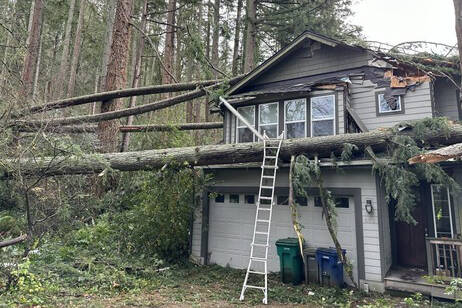Saving King County’s dwindling supply of farmland sounds like a great idea. But how much extra housing will residents of Seattle and suburban cities accept to keep those tractors running?
Lots, hopes County Executive Ron Sims, who is touting a transfer of development rights program as part of his Smartgrowth strategy. The concept is simple: In lieu of developing their property, owners of rural land could sell their development rights, which builders could then use to add units to their in-city developments. “All without any significant impact on the taxpayer,” Sims assured voters at a recent address to the CityClub of Seattle.
See end of article for related links.
Whether the average Seattle homeowner buys Sims’ contention that housing density above and beyond current zoning doesn’t meet the definition of a “significant impact” remains to be seen.
Transfer of development rights (TDR) programs are multiplying nationally, although the amount of land protected thus far has been relatively small. The challenge of setting up a successful program is based on a number of factors. Having established an area in need of protection (“sending area”), officials must choose a “receiving area” where development rights can be transferred. The trick is that the receiving area must be both desirable to developers and willing to accept more density. Municipalities often nudge the process along by establishing a “TDR bank,” which purchases development rights from rural landowners and resells them to urban developers. Although the TDR bank approach removes the uncertainty from the process for sellers, it means government could face a long wait for a return on its up-front investment.
The distance between the land preserved and the development displaced under the King County proposals could add another hurdle. Some TDR programs merely allow developers to develop more intensely on part of a single parcel in return for keeping the remainder of the parcel in rural or open space use. Even Seattle’s successful downtown TDR program—designed to protect historic structures and low-income housing—keeps all transfers within a couple of miles of each other. The few programs that involve long-range transfers of rights are usually built around open spaces of large size and unquestionable significance (such as the program to preserve the million-acre New Jersey Pinelands).
Anna Nissen, an activist who specializes in zoning issues, says the county’s TDR program is poorly timed, as Seattle residents think they’re giving the last word on future zoning changes in the ongoing neighborhood planning process. This after-the-fact push for more density won’t go over well, she predicts. “When the neighborhoods finally figure it all out… it’s not going to sell.”
The wheels are already turning at the County Council, which this week requested that Sims design a TDR program in time for this September’s amendments to the county’s comprehensive plan. Council member Larry Phillips says the county needs to work aggressively to set up the program, then step back and let the private market work. “I’ve been trying to say, ‘OK, let’s stop saying this is a neat idea, let’s put a program in place that works,'” he explains. Phillips wants to see a very selective process for choosing receiving sites in cities, perhaps clustering density around transit stops, Park & Ride lots, and in neighborhoods that want more housing. Although he feels receiving sites can be found, he agrees that the process might be controversial. “Whenever you’re talking about density in urban areas, you have to be careful,” he notes.
The county actually has had a TDR program since 1993, but it has only been used once, says senior policy analyst Kamuron Gurol. The county needs the cooperation of Seattle and suburban cities to successfully operate a TDR program, as unincorporated county areas within the designated urban growth boundary are gradually being annexed by cities. “We need the help of other jurisdictions in order to implement this policy,” he admits.
Gurol acknowledges that the process of choosing Seattle “receiving sites” will raise some controversy. In other TDR programs, development credits are often transferred to sites with a specific zoning designation—chosen with an eye towards preserving neighborhood scale. “We’re not trying to find places to put in a bunch of apartments in the middle of a single-family neighborhood,” he says.
Seattle officials are cautiously investigating the county’s proposals. “At this point, we have said, ‘Yes, we’ll talk,’ because we believe saving rural areas is important,” notes Denna Cline, Mayor Paul Schell’s special assistant on housing issues. However, she agrees that a countywide TDR program could present many obstacles. “It’s not something that’s easy to make work,” she says.
Like any program based on an open-market model, governments may need to do some pushing and pulling through regulatory changes before successes are achieved. For example, while Gurol praises Thurston County’s three-year-old program as well-designed, that jurisdiction has yet to find takers for development swaps. Jackie Kettman, an associate planner for Thurston County Development Services, says there has been more interest in the program so far from developers than from farmers and other rural landowners, “which surprises us,” she says, “because it was the farming community that really wanted this to happen.”
There are tools to spur use of the program: Many jurisdictions reward transfers with increased development rights on the receiving property (a 1-to-2 ratio is not uncommon). Some take a harsher approach by downzoning rural properties or by making landowner participation in the program mandatory. “It’s tough,” says King County’s Gurol. “What you’re doing is creating a market where one doesn’t exist right now.” Still, he thinks TDR could work. He notes that county voters approved a $50 million bond issue in 1979, resulting in the purchase of development rights for 12,400 acres of farmland. King County is in a good spot to be a national leader in TDR, he says. “If it’s going to happen somewhere in this country, it has the best chance of happening here.”
Related Links:
King County site about SmartGrowth





